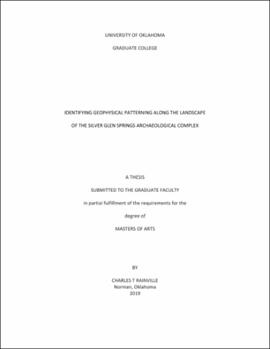| dc.description.abstract | The Silver Glen Springs Complex (SGSC) is a collection of archaeological sites that has been thus-far defined by the terraforming regime of shell mounding conducted by fisher-gatherer-hunters that created many monumental constructions. These mounds were destroyed the 1920s by shell mining companies. Modern archaeological investigations into shell-bearing sites in northeast Florida broadly, and the SGSC specifically, have focused almost exclusively on these mounded spaces, leaving the non-mounded areas adjacent to the shell architecture under-studied. A landscape perspective is taken therefore, in order to understand the articulations of the shell architecture and landscape, as well as the total variability of architecture at this site. Geophysical techniques including ground penetrating radar, magnetic gradiometry, and electrical resistance, in conjunction with small-bore coring and test unit excavation was undertaken during the joint University of Oklahoma and University of Florida field school in the summer of 2018. The geophysical survey was conducted on two open fields located between three previously identified shell-bearing loci. The survey tested two things: first, the efficacy of the geophysical equipment at identifying the total variation of sub-surface shell and second, the patterning of sub-surface anomalies that might be suggestive of architecture. The survey identified archaeologically significant anomalies such as deep basin pits as well as bioturbation and modern terraforming. Additionally, the magnetic gradiometer results in the western extent of the survey area are suggestive of large, non-shell, above ground architecture. This area of possible communal gathering outside of the mounds speaks to the importance of non-mounded spaces and highlights the complicated history of ancient and modern terraforming at the SGSC. This survey also identified modern disturbances that suggest the non-mounded spaces were altered during the early twentieth century shell mining. With this in mind, it is possible that the shell-bearing loci were meaningfully connected prior to shell mining. Ultimately, more work needs to be conducted at the non-mounded spaces at the SGSC in order to understand the complicated history of terraforming outside of shell mounds. | en_US |

